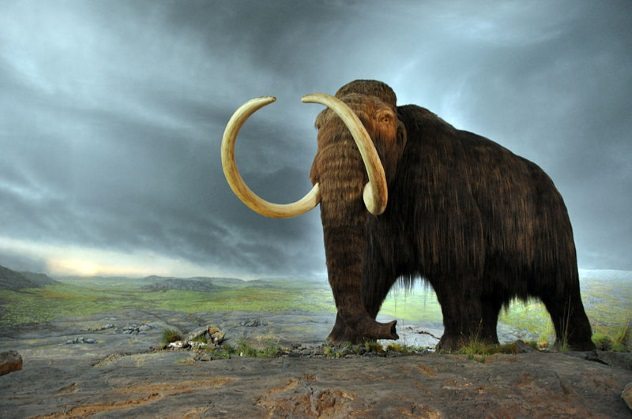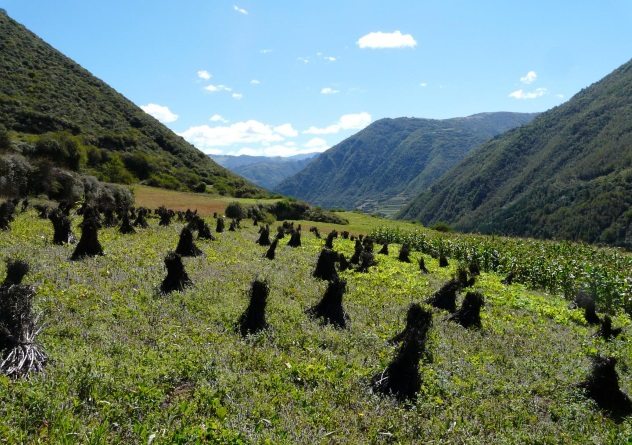As the years have gone by, we’ve found new answers for some of the mysteries, puzzles, and conundrums of our world. It’s unlikely that history will ever reveal all of its secrets to us, but at least we’ve managed to make a few more dents in our collective ignorance.
10 The Death Of Male Mammoths
In 2017, scientists believed they found the answer for a quirk in the fossil record: why almost 70 percent of woolly mammoth remains were male. The research team, led by the Swedish Museum of Natural History, concluded that while the gender ratio was fairly equal at birth, it became skewed due to the hierarchy and living arrangements of mammoth society. Similar to modern elephants, their woolly counterparts lived in groups led by an older matriarch. These groups consisted mostly of female mammoths and their young. Males, however, were kicked out when they reached adulthood and were sent to live on their own or form bachelor groups. Without the support of the herd and the experience of the matriarch, these young males engaged in more “risk-taking behavior.”[1] While this kind of behavior resulted in more deaths, it was also conducive toward preservation. Lone male mammoths were more inclined to fall prey to natural death traps such as sinkholes, bogs, and crevasses. Their remains were buried and protected from weathering unlike most other Ice Age animals, including a lot of their female counterparts.
9 The Missing Swiss Couple
One day, Marcelin Dumoulin and his wife, Francine, went to a meadow near the Swiss village of Chandolin to feed and milk their cows. They weren’t seen again for 75 years. The Dumoulins disappeared on August 15, 1942. They were finally found in July 2017, when a shrinking glacier uncovered their frozen bodies. The ice had preserved the remains, which were found with their belongings and their identity papers intact. Subsequent DNA tests positively confirmed that the bodies were those of Marcelin and Francine Dumoulin.[2] It appears as though the couple fell into a crevasse, where they remained hidden away for decades. Once the Tsanfleuron Glacier started receding, it finally revealed their bodies. According to regional authorities, this sort of thing is not unheard of. Because of climate change, receding glaciers have regularly unveiled the frozen remains of people who disappeared years or even decades ago.
8 Finding The USS Indianapolis
In 1945, the sinking of the USS Indianapolis led to the greatest loss of life from a single ship in US Navy history. The cruiser was on a classified mission to deliver parts for the “Little Boy” atomic bomb at the US Army Air Force Base at Tinian. Afterward, the ship entered training duty but was soon torpedoed by a Japanese submarine on its way to the Philippines. Of the 1,196 crewmen aboard, only 316 survived. The ship firmly entered pop culture with the release of Jaws, in which Captain Quint, depicted as a survivor of the Indianapolis, told the memorable story of how the men who went into the water were preyed upon by sharks for four days before being rescued. As for the vessel, it sank in just 12 minutes before sending a distress signal, resting on the bottom of the ocean somewhere between Guam and the Philippines. Over the last two decades, two expeditions tried and failed to find the wreckage using modern technology. In 2016, a new lead emerged when records showed that the Indianapolis passed by another ship 11 hours before being attacked. Using the other vessel’s known route, a new expedition bankrolled by Microsoft co-founder Paul Allen estimated the location of the shipwreck. Over a year later, they finally found the USS Indianapolis in the North Pacific Ocean at a depth of 5,500 meters (18,000 ft).[3]
7 Painting The Terra-Cotta Army
Researchers in China believe they’ve solved the 2,200-year-old mystery behind the polychrome paint of the famous Terra-Cotta Army. Discovered back in 1974, the Terra-Cotta Army is a vast collection of almost 9,000 statues representing soldiers, chariots, and horses buried with the first emperor of China, Qin Shi Huang, to serve as his imperial guard in the afterlife. When they were found, some of the sculptures still contained patches of colorful pigment and minute remnants of binding material, something exceedingly rare in statues buried underground in water-saturated sediment for over two millennia. The pigments have previously been identified—inorganic compounds such as cinnabar, azurite, and malachite—but the bonding agent and the precise method used to paint the Terra-Cotta Army remained elusive until now. To find their answer, Chinese scientists used a state-of-the-art technique called matrix-assisted laser desorption/ionization time-of-flight mass spectrometry (MALDI-TOF-MS).[4] The high levels of sensitivity provided accurate results despite trace amounts of bonding agent. The results were then compared to “artificially aged” samples of period-accurate adhesives through peptide mass fingerprinting, which identified the proteins in each specimen. According to the study, ancient Qin dynasty artists first coated the sculptures in one or two layers of lacquer obtained from a Toxicodendron tree, commonly known as the Chinese lacquer tree. Afterward, they either applied polychrome layers directly or, in most cases, used binding media made out of animal glue.
6 The Mystery Of Blood Falls
In 1911, geographer Thomas Griffith Taylor came upon a curious course of water flowing from the tongue of Taylor Glacier in East Antarctica. It earned the name Blood Falls due to its ruddy color, which puzzled scientists for over a century. Initially, people believed the coloration was due to red algae. However, this was disproved, and researchers realized it was iron oxides that turned the water red, although they weren’t sure how or why until 2017. A joint study between Colorado College and University of Alaska Fairbanks used radio-echo sounding radar to discover that the waterfall was connected to a large source of briny water which could have been trapped under Taylor Glacier for over one million years. Due to the high concentration of salts, the 91-meter (300 ft) path of brine stood out well against the fresh ice surrounding it. However, researchers were astounded to find liquid water at all, something they thought impossible inside an extremely cold icy mass. In fact, Taylor Glacier is now the coldest known glacier to have persistently flowing water.[5] The discovery has particularly intriguing implications for astrobiologists, who consider harsh environments like that of Blood Falls similar to what we might encounter on other worlds such as Jupiter’s moon, Europa. It provides them relatively easy access to extremophiles without having to drill through ice caps, potentially contaminating intact environments.
5 Why The Largest Primate Went Extinct
While it is generally agreed that Gigantopithecus was the largest primate to ever roam the Earth, the few fossils we have provide us an unclear picture of its true size. Experts say it was anywhere between 1.8 to 3 meters (6–10 ft) tall and between 200 and 500 kilograms (440–1100 lb). They also can’t say for certain how long Gigantopithecus was around for, although they opine that the giant ape existed between nine million and 100,000 years ago. Despite all the uncertainty, researchers at the Senckenberg Center for Human Evolution and Palaeoenvironment (HEP) in Germany believe they have elucidated at least one mystery surrounding the primate—why Gigantopithecus went extinct. According to them, the ape died out due to its inability to adapt.[6] By studying the tooth enamel of fossils, they ascertained that Gigantopithecus was exclusively a vegetarian, but it didn’t eat only bamboo as others had suggested. This diet restricted the primate’s habitat to forests. However, during the Pleistocene, large areas of wooded landscapes in China and Thailand where Gigantopithecus lived turned to savannas. This had a major impact on the ape’s food sources, which led to its extinction before it could adapt to a new diet.
4 The Flight Of Barry Troy
On February 25, 1958, Lieutenant William Thomas Barry Troy of the Royal Canadian Navy was flying a F2H-3 Banshee jet to the naval air station in Mayport, Florida. However, the 29-year-old pilot fell out of his four-plane formation and was never heard from again. Although he was presumed dead, all we ever recovered was his helmet and a wheel from the aircraft. In 2017, Hurricane Irma became one of the most destructive storms on record, causing over 100 fatalities and tens of billions of dollars in damage. Another thing it did was help to elucidate the 59-year-old mystery of Lt. Troy’s disappearance. A park ranger from Florida’s Hanna Park saw a pile of debris wash ashore. Upon closer inspection, he noticed it contained parachute rigging with the words “Lt. (P) Troy” inscribed on the harness.[7] Most likely, the chute had been buried under sand dunes for decades before being brought to the surface by the hurricane. It appeared that the parachute was never deployed. No human remains or substantial pieces of plane wreckage were found, so it’s still unclear if Lt. Troy’s plane crashed in the same area.
3 The Tibetan Millet Mystery
A new agricultural study from Washington State University seeks to provide an answer for the apparent mass exodus seen on the fringes of the Tibetan Plateau roughly 4,000 years ago. According to a team led by archaeologist Jade D’Alpoim Guedes, climate change could have driven away the ancient people of the Eastern Tibetan Highlands by making it impossible for them to grow millet, their primary food source.[8] Archaeological evidence shows us that millet was the main crop cultivated in the area toward the end of the warm period known as the Holocene Climatic Optimum. Afterward, global temperatures cooled down, which had an adverse impact on Tibetan agriculture. Millet became very difficult to cultivate due to its high heat demands. The food shortage caused more and more people to leave seeking greener pastures. It wasn’t until 300 years later that the region began to bounce back due to the introduction of wheat and barley, which fared much better in cold weather and almost immediately became the new preferred crops. Curiously enough, the ancient millet seeds could make a comeback in the near future as the Tibetan Plateau is now one of the areas with the fastest-rising temperatures on the planet.
2 The Curious Extinction Of The Tasmanian Tiger
The last known thylacine, also known as the Tasmanian tiger, died in captivity in 1936. Since then, thousands of people reported unverified sightings, but with no confirmed records, the animal was declared officially extinct 50 years later. While the continued existence of the thylacine is still up in the air, researchers believe they have solved another mystery surrounding the animal: why it survived on the island of Tasmania when it died out in mainland Australia thousands of years ago. One hypothesis claimed a disease wrecked havoc on the mainland population. Another said the thylacine went extinct due to its competition with the dingo, an animal not found on Tasmania. However, researchers at the University of Adelaide argue that it was climate change—specifically drought caused by the El Niño weather pattern—which resulted in the mainland extinction.[9] Scientists at the Australian Center for Ancient DNA sequenced 51 new DNA genomes from thylacine fossils. Their findings showed that Tasmanian tiger populations in Southern Australia split into western and eastern divisions approximately 25,000 years ago. They also showed that the drought had an adverse effect on thylacine numbers in Tasmania, but the higher rainfall offered the island a degree of protection from the warm weather. Therefore, the animal population was able to bounce back before Europeans arrived in the 18th century.
1 Solving America’s Oldest Unsolved Murder
In 1607, Jamestown, Virginia, became the first permanent English settlement in the Americas. For the last two decades, it has also been at the forefront of Colonial America archaeology since the Jamestown Rediscovery Project led to the reveal of the ruins of the original James Fort. Originally slated to last only ten years, the venture has been prolonged indefinitely due to the continued discovery of new artifacts and knowledge. Part of the findings in 1996 included the skeleton of a young man given the designation JR102C. He had been shot in the right leg, and the lead bullet was found alongside the remains. His 400-year-old death became an unsolved murder. It took over 17 years since his rediscovery, but in 2013, forensic archaeologists announced that they had identified not only the victim but also his killer. They believe JR102C was shot in a duel, as he was hit in the side of the knee, suggesting he was positioned sideways. Based on records and other evidence, researchers named George Harrison as JR102C and a merchant named Richard Stephens as his killer.[10] The two took part in a duel in 1624, in which the latter shot the former in the leg, with Harrison subsequently dying of blood loss.
























